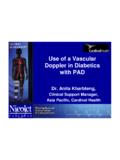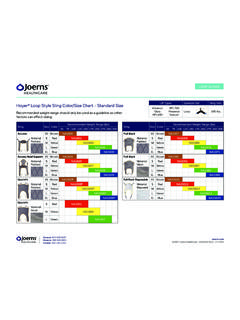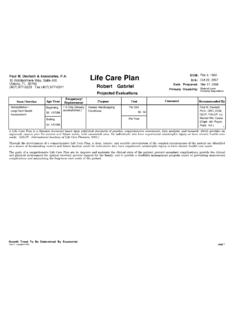Transcription of 12/6/2015 - Prosthetics and Orthotics - Hanger Clinic
1 12/6/20151 Continuing Education SeriesOverview of the Trauma Patient Pathway and CareContinuing Education SeriesHanger s Continuing Education SeriesSpinal OrthoticsLower Extremity OrthoticsUpper Extremity OrthoticsLower Extremity ProstheticsUpper Extremity ProstheticsTrauma EducationContinuing Education SeriesDisclosure StatementsPlease state your disclosures verbally to the audience. 12/6/20152 Continuing Education SeriesGoals & Objectives Identify current research trends Define the trauma patient care pathway Instill knowledge and hope to maximize potentialContinuing Education SeriesDriving AdvancementsContinuing Education SeriesWhy me?
2 12/6/20153 Continuing Education SeriesTriple ThreatContinuing Education SeriesMy StoryContinuing Education SeriesTrauma Patient Insights12/6/20154 Continuing Education SeriesAmputation Statistics Approximately 2 million people in the US are living with limb loss today 185,000 amputations occur annually Among those with amputation-54% vascular related-45% trauma-less than 2% cancer The state of Texas accounts for around 9% of that national totalContinuing Education SeriesTraumatic Amputation StatisticsThe most common causes of accidental traumatic amputation injuries are as follows:1.
3 Traffic accidents (including bicycles, trains, motorcycles)2. Workplace/factory/construction accidents3. Agricultural accidents 4. Firearm/explosives/fireworks accidents (includes military casualties)5. Electrocution accidents6. Ring traction accidents7. Building and car door accidentsContinuing Education SeriesTraumatic Amputation StatisticsMost common cause of traumatic amputation in children:12/6/20155 Continuing Education SeriesTrauma patient demographics80% of traumatic amputees are: Male Between the ages of 15 40 In general good healthContinuing Education SeriesTrauma patient demographics Employed and typically the breadwinner of the family Hanger ClinicContinuing Education SeriesTrauma patient demographics Activities Goals for Recovery 12/6/20156 Continuing Education SeriesTrauma patient demographicsLimb Salvage vs.
4 AmputationContinuing Education SeriesTrauma Patient Pathway and CareContinuing Education SeriesTrauma Insight Decision maker First initial contact w/patientSurgeon/ER Staff Options Outcomes Knowledge on resourcesHospital and Rehab Allied Health Care Partners Optimize recovery outcome Continuity of carePatient and Family12/6/20157 Continuing Education SeriesPathway and ResourcesFamily, Friends&Peer SupportOccupational Therapist; Physical TherapistCase Manager &Social WorkerER PhysicianO&P ClinicianPatientER physician and StaffCase Manager and Social WorkerNurseTherapistsFamily and Peer SupportO&P CliniciansPsychological SupportContinuing Education SeriesPathwayContinuing Education SeriesThe Pathway From Education Finish!
5 !!!!Continuing Education SeriesThank You andFeedback!Overview of the Trauma Patient Pathway and CareVisit: provide us with feedback on this Education SeriesCitations National Trauma Institute. ( ). Retrieved November 6, 2015 , from Home. ( ). Retrieved November 6, 2015 , from Reference: Hanger Clinic Primary Research12/6/20151 Continuing Education SeriesPostoperative Care Following Traumatic AmputationObjectivesUpon completion of this presentation, the participant will be able to: Describe the postoperative & early rehabilitation process for lower extremity traumatic amputation.
6 Describe the goals and benefits of postoperative management Compare the effectiveness of various forms of postoperative prosthetic treatments Develop a post-op & rehab treatment planAgenda Introduction Postoperative & early rehabilitation process for lower extremity traumatic amputation Goals/benefits of postop management Effectiveness of postop prosthetic treatments Rehabilitation Treatment Plan and Peer Support12/6/20152 Rehabilitation from AmputationThree phases:1. Healing2. Maturation3. DefinitiveRheinstein, Wong and Edelstein, 2006. Lower Extremity ReviewGeneral Rehabilitation Timeline for Patients with Lower Extremity AmputationReceive permanent prosthesisPre-prosthetic training period frompresurgery to temporary deviceSutures removed; limb shapingTe m p o rar y prosthesis; Begin prosthetic gait training Apply post-operative protectorIncision fully healed; Cast for prosthesisOngoing therapy and prosthetic adjustments1 year6 wks8 wks4 wks0wks4 mons.
7 **Individual experiences will vary. Slow healers have a different timelineAdapted from Initial Considerations for In-PatientsResidual limb Edematous Painful Critical statePatient overview Mechanism of injury Comorbidities TBI BackgroundEmotional well being Ellen Webber for Otto , Wong and Edelstein, from Hospital Protect surgical wounds Proper prosthetic care can reduce complications Quality & amount of attention devoted to patient determine outcomes Location and access to f/u drives post-op device selection Notify your Hanger prosthetist of date and location of dischargeImages Charles Krupa, AP,and Pat Greenhouse.
8 Boston Globe StaffGoals of Postoperative Treatment Heal the surgical wound Protect the amputated limb from trauma Minimize pain Reduce swelling & begin shaping amputated limb Preserve & improve ROM & strength of entire body TIRR Memorial Hermann Rehabilitation & ResearchGoals of Postoperative Treatment Enable patient to learn to use appropriate mobility aids Begin controlled weight bearing Accomplish functional activities Facilitate psychological adjustments to limb loss (Peer support - AMPOWER) Otto Bock12/6/20154 Goal of Prosthetic Rehabilitation Return the patient to daily life at highest possible level Image Charles Krupa, APSigford, , of Postoperative CareOver 400 articles describe postoperative treatment and consistently validate the benefits: Reduced pain Reduced time to prosthetic use Reduced hospital stayKey to early mobilization: Healing the wound Shaping the residual limbPunziano A, et al.
9 , RW, Marks A, Higman D, Complications1. Fall trauma2. Wound dehiscence Infection/slow healing3. Contractures4. Edema5. Pain Image by Lew Schon, of Falls Evidence 20% of lower extremity amputees experience a fall in the hospital 3% of all LE amputees experience a fall significant enough to require revision surgery 47% of those revision surgeries result in a higher level amputation Revision surgery due to a fall is reduced through the use of a Removable Rigid Dressing Hospital is responsible for falls costs for Medicare patientsYu JC, Lam K, Nettel-Aguirre A, Donald M, Dukelow S.
10 Incidence and risk factors of falling in the postoperative lower limb amputee while on the surgical ward. PMR 2010 Oct;2(10):926-34. doi: , H, Hunter, J. Preventing falls and stump injuries in lower limb amputees during inpatient rehabilitation. Clinical Rehabilitation 2004;18: 379 T, Devlin M, Heslin K. Falls sustained during inpatient rehabilitation after lower limb amputation: Prevalence and predictors. Am J Phys Med Rehabil2006;85:521 , H, Hunter, J. Preventing falls and stump injuries in lower limb amputees during inpatient rehabilitation. Clinical Rehabilitation 2004.







